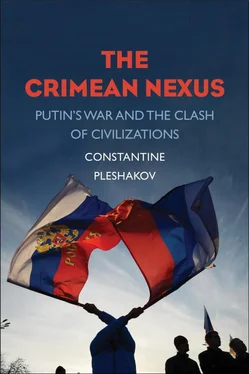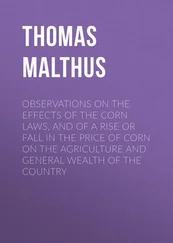The steppe, the mountains, and the littoral tended to have amazingly little contact with each other—three separate realms on the meager ten thousand square miles, meeting mostly at border trading posts. Ruins of miniature but sturdy fortifications still block every north-to-south gorge connecting the littoral to the plateau. Built fifteen centuries ago by the order of a Byzantine emperor, and differently referred to by later visitors as “castles,” “fortresses,” or just “walls,” in their prime they sealed every hole in the mountain range. A small Byzantine garrison guarded each one, wardens of a rich realm threatened by marauders. Most of them stood in clear visibility of each other, meaning that every suspicious activity on the border, let alone a breach, would be swiftly communicated along the whole security perimeter. [6] Pyotr Keppen, Krymskii sbornik. O drevnostyakh yuzhnago berega Kryma i gor Tavricheskikh (St. Petersburg: Imperatorskaya Akademiya Nauk, 1837), 45, 57; Maria A. Sosnogorova, Putevoditel’ po Krymu dlia puteshestvennikov (Odessa: L. Nichte), 1871, 125.
Until the first time the Russians conquered Crimea, in 1783, the littoral region existed independently from the rest of the peninsula. Greeks developed it in the seventh century BCE; Romans and Byzantines maintained what the Greeks had left them; and so later did the merchant republics of Genoa and Venice. No Mediterranean power ever tried annexing the rest of the peninsula. The only thing Mediterraneans wanted in Crimea was a string of trading posts, and the littoral, the meeting place of the Asiatic steppe and the Mediterranean city, served the purpose. The littoral received little investment, and no significant public buildings or urban spreads. What the maritime people needed was port facilities, fortresses, and a handful of northbound highways.
Europeans used Crimea as a mudroom, Europe’s easternmost port of entry, a place were you dress up for the journey or unwind on completing one. Constantinople was just two days away by sail—by Middle Ages standards, practically a commuting distance. For Silk Road businessmen like Marco Polo, it was the last respite before stepping into the unknown, the edge of the familiar world. It did not merit more than two lines in Polo’s book of travels (“taking their departure from Constantinople,” the merchants reach a “port named Soldaia,” whence the longest leg of their eastward journey started). These settlements became the foundation for Crimea’s future urban structure. The majority of Crimean cities and towns—Sevastopol, Yevpatoria, Feodosia, Kerch, Alushta—grew on antiquity’s humus. [7] Marco Polo, The Travels (Köln: Könemann, 1996), 10; The Journey of William of Rubruck , 51.
The only formidable structures Mediterraneans ever built on the peninsula, fortresses, came into disuse long ago and now exist mostly as ruins. To see majesty beyond neglect and decay, one has to refer to their Italian prototypes in Liguria and Golfo della Spezza (the Genoese castle in Crimean Gurzuf, for example, was modeled on the fortress in Lerice). For the Republic of Genoa, the Crimean littoral and its eastward continuation on the Sea of Azov were important enough to deserve a special bureau in the central government, the Office of Gazaria (as Italians called the area at the time).
In addition to the Silk Road, filling Crimean warehouses with spices, pearls, cloth, and precious stones, the coast served the northbound route to what later would become Ukraine and Russia. From the river Don came a novelty—caviar, the salted fish eggs of sturgeon. Slavic merchants brought furs and slaves. Even Catholic missionaries did not have to think twice before buying a boy when in need of a companion for a long journey to heathens’ lands. Because Italians preferred light-skin people, Russian, Polish, and Ukrainian slaves were in greatest demand. [8] Pero Tafur, Travels and Adventures (1435–1439) (London: G. Routledge, 1926), 132–134; The Journey of William of Rubruck , 50; Keppen, Krymskii sbornik , 176; Steven A. Epstein, Genoa and the Genoese, 958–1528 (Chapel Hill: University of North Carolina Press, 1996), 193, 267; A. Bezchinsky, Putevoditel’ po Krymu (Moscow: I. N. Kushnerev, 1908), 379.
Everything could be sold and bought in Kaffa, the main port and trading center for the Genoese, and now known as Feodosia. Horrified by the sight of “fathers selling their children and brother selling brother,” tavern owners offering lodgers “young virgins for a measure of wine,” a Spanish traveler called the city the place of evil doings, theft, and wickedness. [9] Tafur, Travels and Adventures , 132–134.
The three Crimean realms—the steppe, the mountains, and the littoral—hang in a fragile balance, overlapping only tentatively. That changed when a new nomadic group invaded from the north: Mongols.
The Turkic name for the peninsula is Kirim—“fortress.” Other languages adopted this term; the English “Crimea,” or Russian and Ukrainian “Krym,” all originate in corrupted Turkic.
As the inhabitants of Crimea were ignorant of the scope, charge, and potential of the Mongol conquests, their invasion at first looked like any other. But the Mongols were the first group in history to occupy the whole of the peninsula, not just the steppe but the mountains and littoral too.
The Genoese colonies proved difficult to subdue. War for the littoral lasted for several decades. A freak yet monumental consequence was the Black Death pandemic in Europe. Plague bacterium lives on the arid plains of Central Asia, and advancing west, the Mongols had to cross those. The Mongol army group that besieged Genoese Kaffa in 1346 suffered an outbreak of the disease causing more casualties than war. Their commanders ordered the Mongols to catapult the dead bodies into the besieged city—perhaps the earliest occasion when biological warfare was employed. The Genoese colonists fleeing Kaffa carried the disease to Constantinople and then to Italy, thus triggering the catastrophe that eventually killed at least 75 million people. [10] Epstein, Genoa and the Genoese , 211–212.
Within two generations after their invasion of Crimea, the Mongols adopted Islam. Genghis Khan and his generation had worshiped “Tengri, the god of the blue sky,” but in the early 1300s a ruler of the Golden Horde together with his aristocracy converted to Sunni Islam. Crimea saw its first mosque built in 1314. [11] Williams, The Crimean Tatars , 13.
The peninsula became part of umma , the global Muslim community, and of the Dar al-Islam, or House of Islam, metaphysically opposed to the lands of unbelievers, Dar al-Harb, the House of War. Meanwhile, across the sea in the Balkans and Anatolia, a new hegemonic power emerged: the Ottoman Empire. With the Golden Horde’s conversion, Mongols and Turks now shared a cultural space. [12] Ibid., 12.
The Ottomans’ clash with the Byzantines and the West transcended the standard pattern of struggling for territory and resources. What had started as a border war grew into a clash of three civilizations—Islamic, Eastern Orthodox, and Western.
For a century, Crimea remained a province of the Golden Horde; as the Mongol empire weakened, it broke away to form the Crimean Khanate. This was ruled by a Genghizid, as Mongol custom dictated, but its independence was short-lived (1443–1475). War flared up between clans, pretenders, the Italians, and the still unconquered mountaineer Goths. After a faction of clan leaders asked the Ottomans for help, the Ottomans landed in Crimea, defeated every party, and turned the peninsula into their protectorate.
The Ottoman era in Crimean history did not cancel the structures laid down before but built upon them. The Ottomans let the khanate control the steppes and the mountains, but they claimed the littoral as their own, turning it into a province of the empire. Unlike previous Mediterranean colonizers, they took over the whole coastal perimeter and built fortresses along its entire length, the biggest at the northern gateways, Perekop and Arabat, and then continued the line of coastal fortifications east and west. The Black Sea became known as the Ottoman Lake. [13] Evliyá Efendí [Evliya Celebi], Narratives of Travels in Europe, Asia, and Africa in the Seventeenth Century (London: Oriental Translation Fund, 1834), 92–93. Williams, The Crimean Tatars , 46; Yury Shutov, Arabatskaya strelka (Simferopol: Tavria, 1983).
Читать дальше












